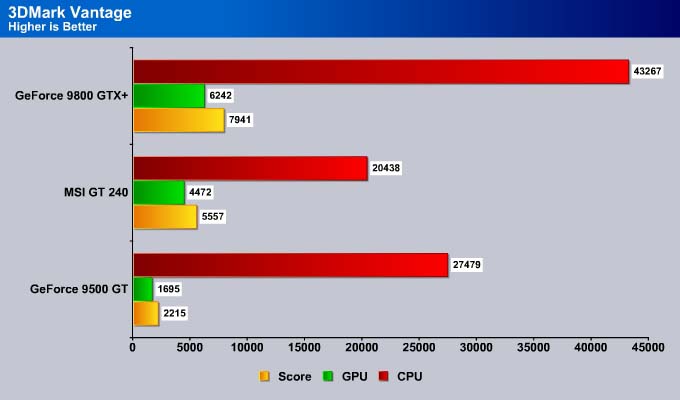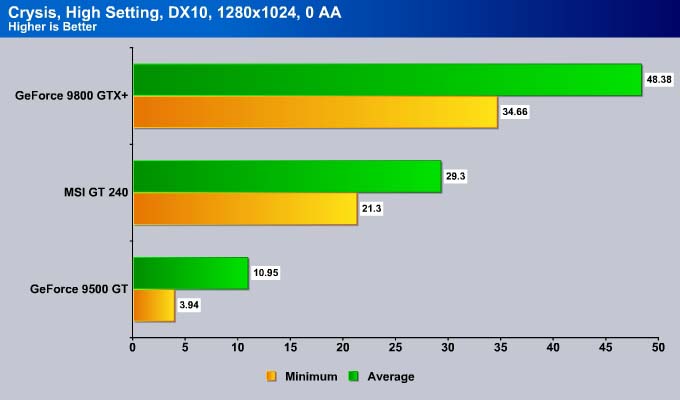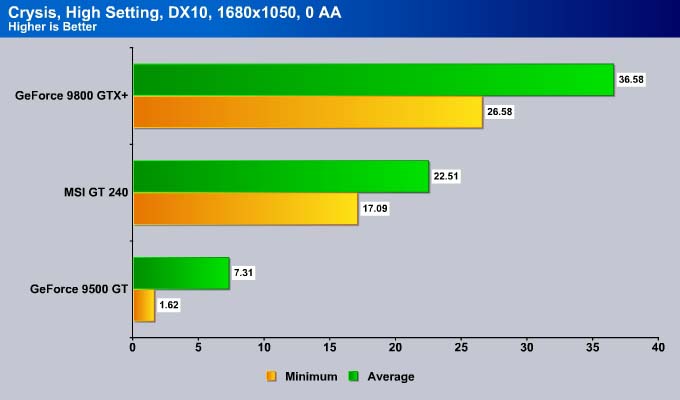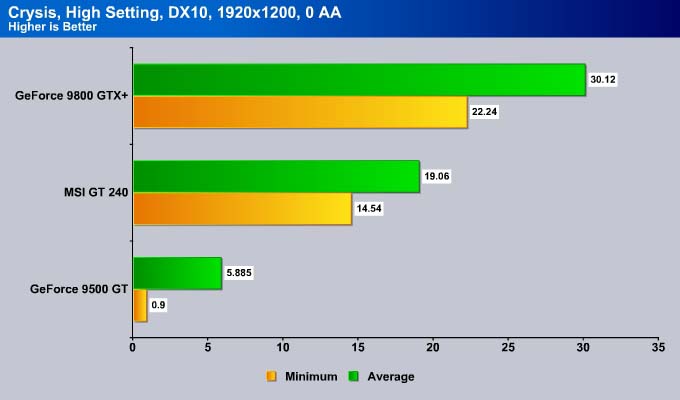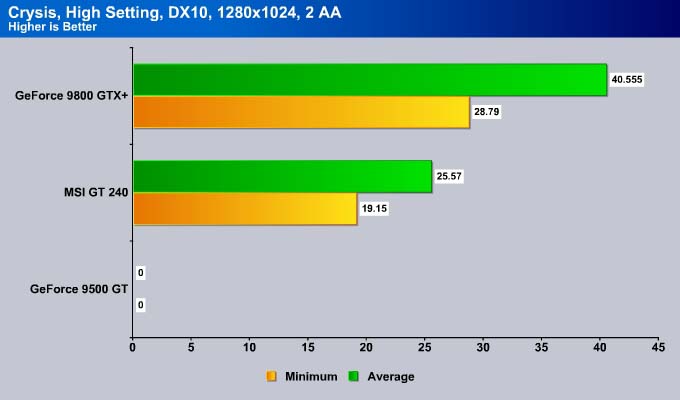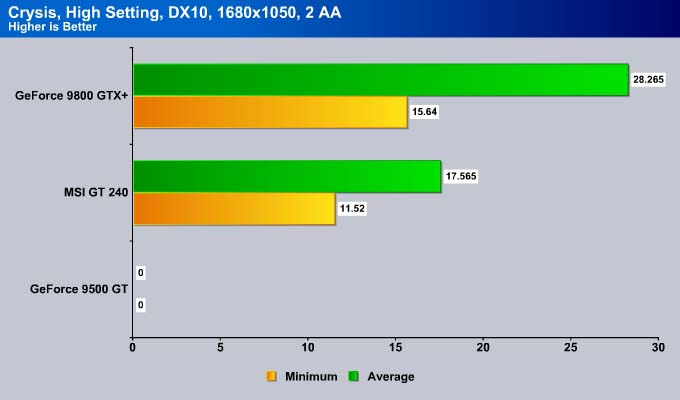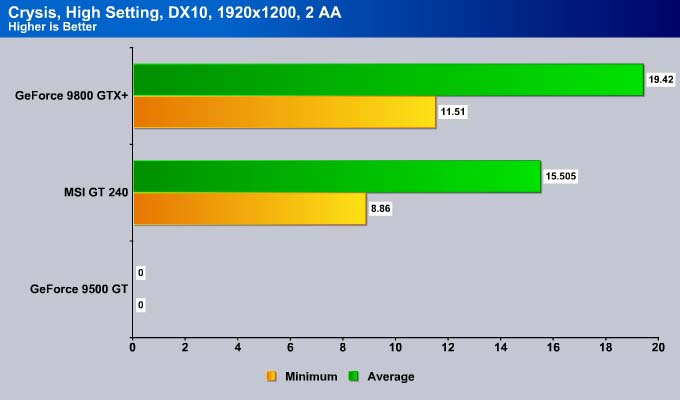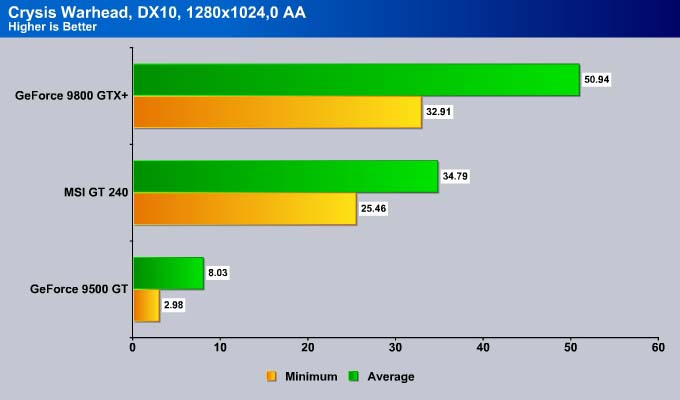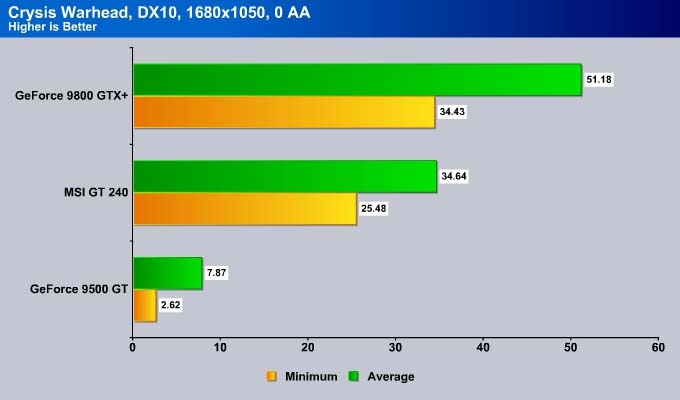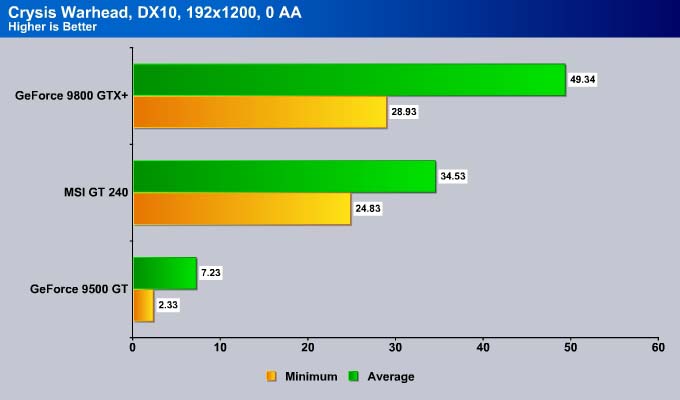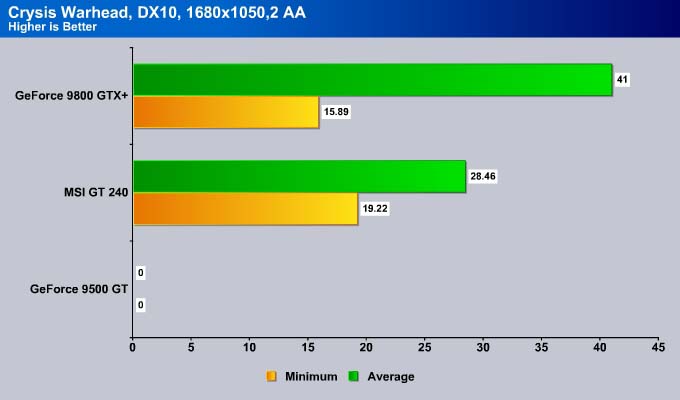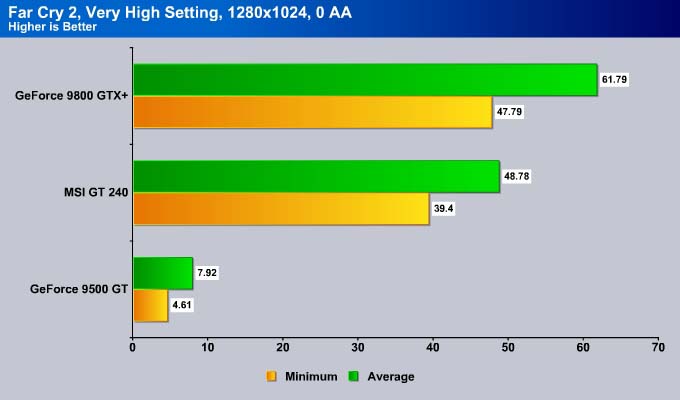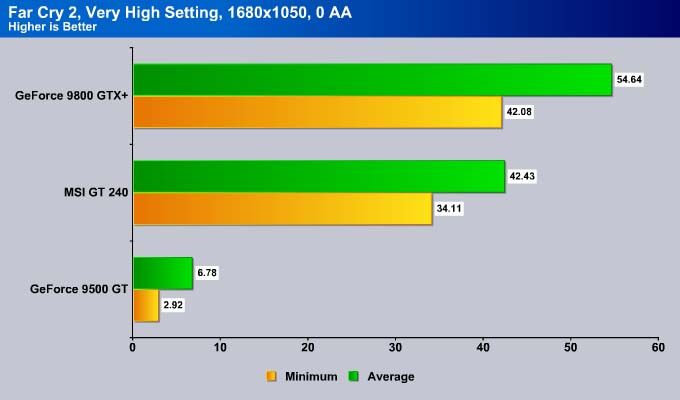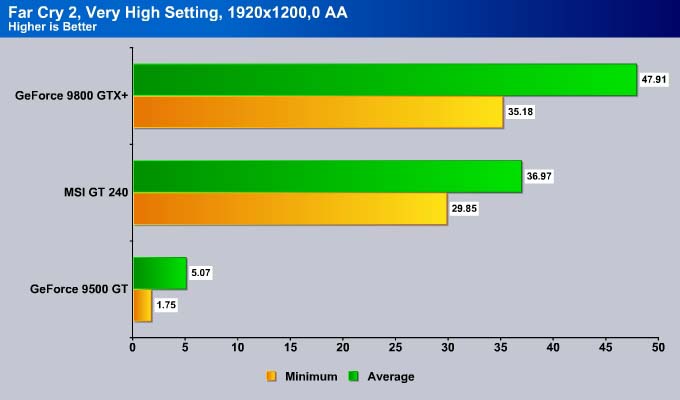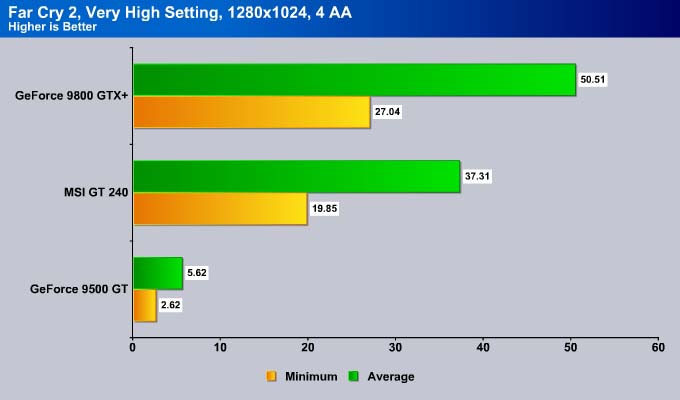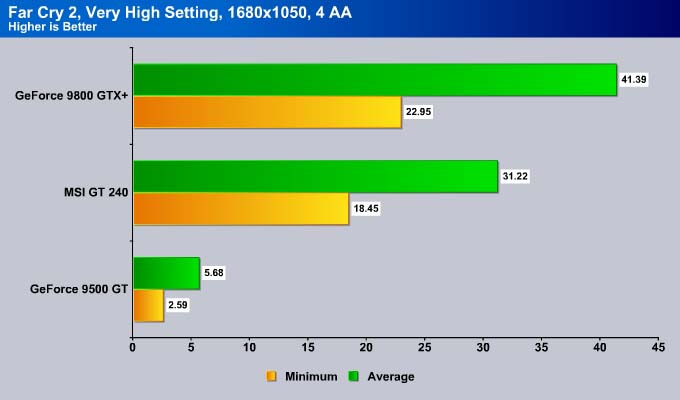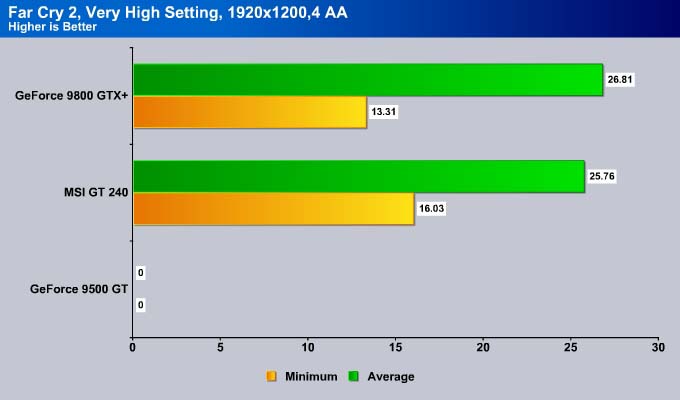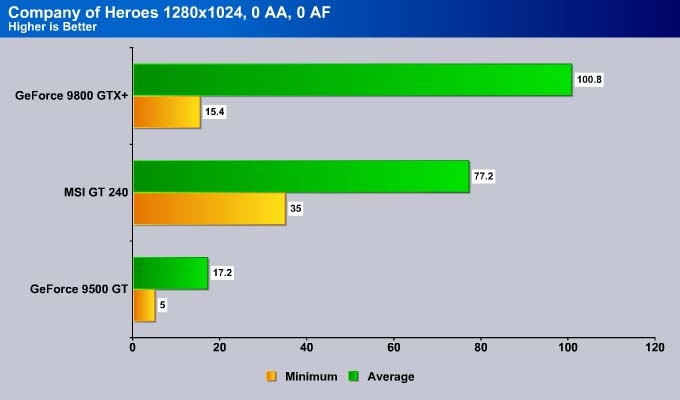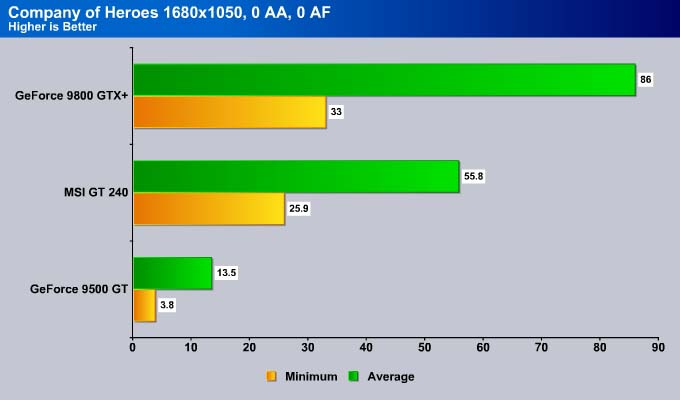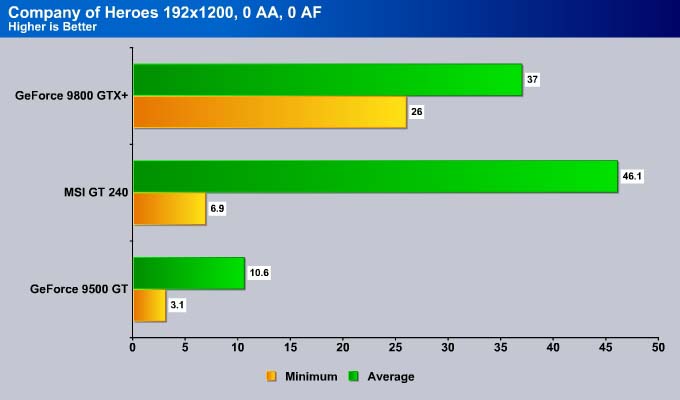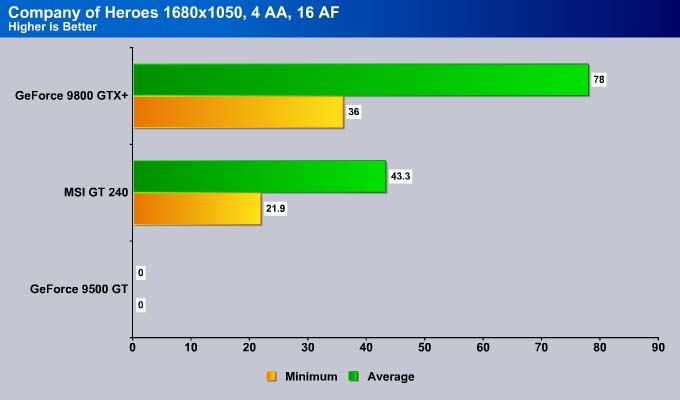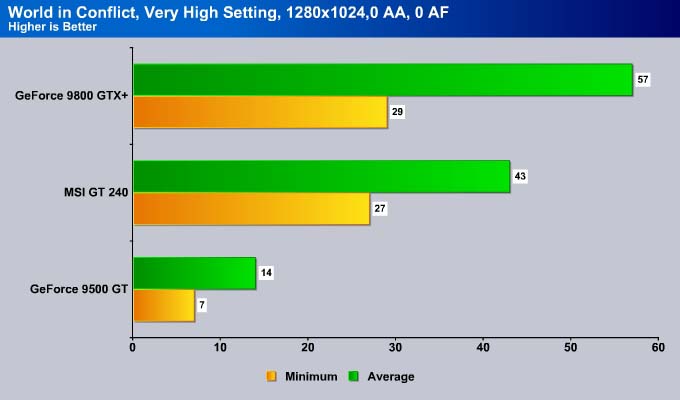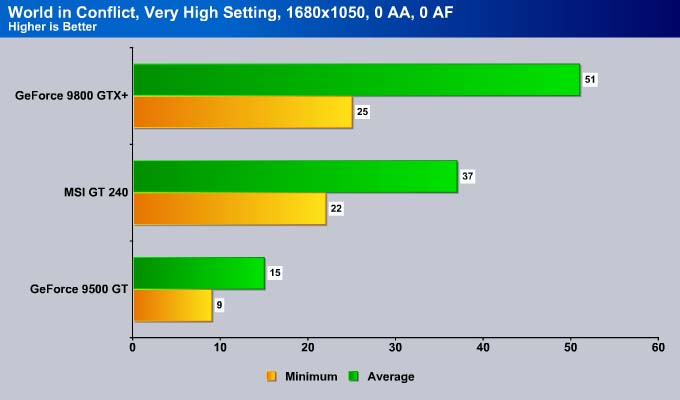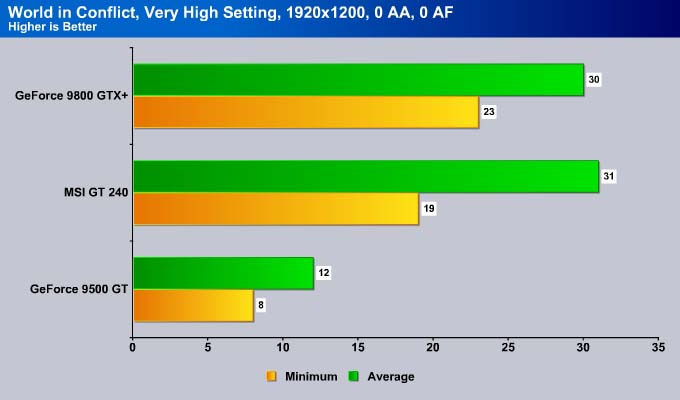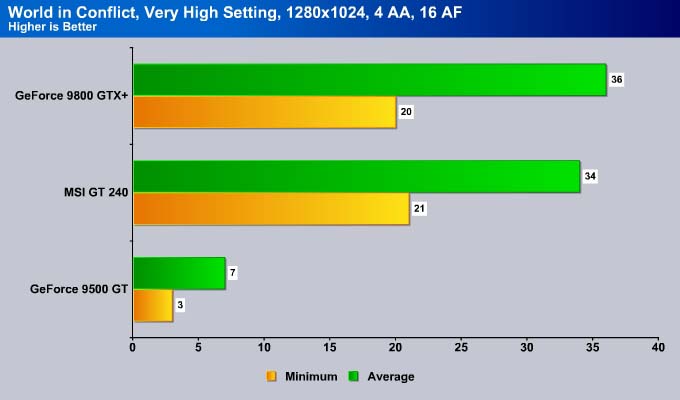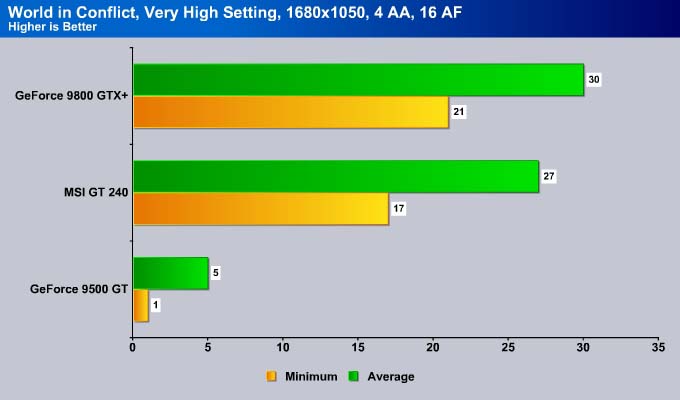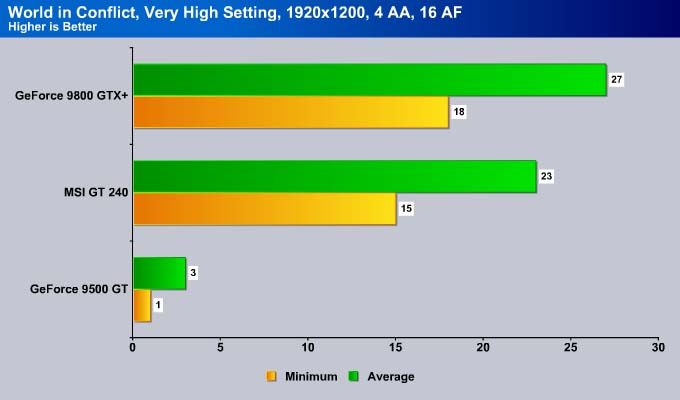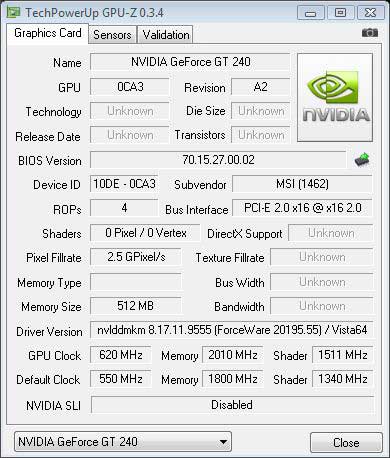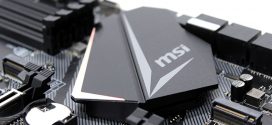MSI N240GT-MD512 OC/D5 is based on the NVIDIA GT 240 that paired with GDDR5 and offers native 7.1 audio support through HDMI and DirectX 10.1 support. All these new features are much welcomed for HTPC which makes this an idea card for such task. How about its performance? Let’s find it out.
INTRODUCTION
As the worlds patiently awaits NVIDIA Fermi which is aimed to challenge the ATI Radeon HD 5870, the graphics giant is not sitting idling. In fact, NVIDIA has been busying updating their existing lineup. NVIDIA has revamped the entire graphics line up to the 200 series.
Although many people may think that NVIDIA simply “recycles” their old cards and rebrand the name, the reality is that the latest line of the 200 series graphic cards actually packs some feature upgrades. The latest GT 240 from NVIDIA is manufactured with the 40nm processing technology that will ensure the card runs cooler than previous generation of cards. Not only that the card runs cooler, it also consumes less power. As a result, the GT 240 draws power directly from the PCI Express slot and does not need any auxiliary power. This is good news for those who wish to upgrade their system without spending extra money on a power supply.
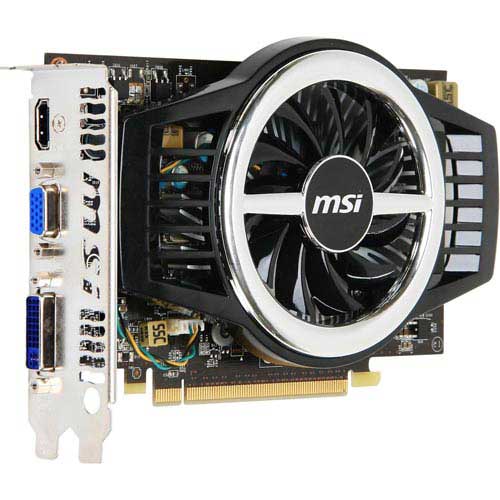
In addition, NVIDIA is finally using GDDR5. While AMD has been using GDDR5 since HD 4000 Series, NVIDIA is slow in adapting the technology until now. The GT 240 also supports native HDMI port with 7.1 audio output.
NVIDIA also upgraded the DirectX to 10.1. Although the industry is moving toward DX11, it is nice to see the upgrade nonetheless.
All of these upgrades make sense because people who are looking for a card to setup their HTPC will not likely going to spend a lot of money for a high-end graphic card and opt for a budget card that fits their need and budget.
CLOSER LOOK AND FEATURES
Our review sample N240GT-MD512-OC/D5, courtesy of MSI, arrives at our door step a day after NVIDIA released the GTS 240. Thus, we could not get the review in time for the launch day. The MSI N240GT is packaged in a rather small box that is typical for cards selling at this price segment. The box has plenty of marketing information for any potential buyer to read.
Being that this is more of a budget card, we do not expect that it will bundle with much accessory. In fact, you ony get the card, a quick installation guide, the driver CD, and a marketing pamphlet about the MSI N240GT Series cards.
Our review sample, the N240GT-MD512-OC/D5, comes with 512MB of GDDR5. The core is running at 550MHz and the memory is running at 3600 MHz. All GT 240 comes with 96 stream processor and 128-bit memory interface should provide decent bandwidth.
What sets the MSI GT 240 from the competitors is the included over voltage function which according to MSI can offer performance up to 30%. The card is also built with Hi-C CAP, and Tantalum Core that offers a high conductivity and less leakage. In addition, solid state choke with pure iron core to offer better power protection and reduce the buzzing noise that is often found in the latest generation of cards. The card is also made with solid capacitor with aluminum core which according to MSI should last for 10 years.
For average users, these underlying technologies actually translates to cooler card, more power efficient card, and stability. What is more important is probably the potential overclocking that the card may offer.
The card is pretty small with a tad shorter than 7 inch in length. As you can see from the picture above that it takes two expansion slots due to the larger heatsink that MSI uses on the card. We actually prefer to see a single slot cooler for this card since we believe this would be an ideal card for HTPC where often people will be using mATX board with less expansion slots. Furthermore, a 60 mm fan is on top of the card to assist the cooling. Again, we would actually prefer to see a passive cooling if possible for this level of the card. However, for those who are into overclocking, the extra cooling sure would be appreciated.
For the output, the card comes with one DVI, one VGA, and one HDMI. As mentioned earlier, the HDMI port supports audio so no long that you need to use the internal audio bypass cable to hook to the motherboard SPDIF. NVIDIA supports the 7.1 audio.
We see MSI places some ventilation holes on the back of the card. It’s kind of nice that they drill the company logo on the back for the ventilation holes.
MSI bundles the card with the following software:
- Driver
- Afterburner (MSI version of overclocking tool)
- MSI Live Update 4 (where you can use to download)
- Adobe acrobat reader
- Cyberlink PowerDVD 7 and DVD Solution Trial
- Norton Internet Security 2010 60 Free trial
- TMPGEng 4.0 Xpress Special Trial Version
Methodology
To test this card, we did a fresh load of Windows 7 Ultimate 64 bit and applied all the patches and updates for the OS, then we updated all the motherboard drivers and made sure that we had the latest NVIDIA drivers. We didn’t install any video drivers on the test rig at first, we just installed the basics and then cloned the hard drive using Acronis. That way when we switch from the ATI GPU to the Nvidia GPU we can have a fresh load with no old drivers hanging around to bugger up our benchmark numbers.
We ran each test 3 times and averaged the results, the average of those results are reported here. The one exception to the 3 run rule is Stalker, this test is just long so all of the individual tests were averaged together. Below is a detailed list of the components used during testing.
| Test Rig | |
| Case | None |
| CPU | Intel i7 920 @ 3.2 Ghz |
| Motherboard | Gigabyte X58-UD4P |
| Ram | (6x2GB) DDR3 Kingston HyperX 1600 |
| CPU Cooler | Prolimatech Megahalem |
| Hard Drives | Seagate 7200.11 1.5TB |
| Optical | Nec DVD-RW |
| Testing PSU | Cooler Master UCP 900W |
Synthetic Benchmarks & Games
| Synthetic Benchmarks & Games | |
| 3DMark 06 | |
| 3DMark Vantage | |
| Crysis | |
| Crysis Warhead | |
| Far Cry 2 | |
| Company of Heroes | |
| World in Conflict | |
3DMARK06 V. 1.1.0
3DMark06 developed by Futuremark, is a synthetic benchmark used for universal testing of all graphics solutions. 3DMark06 features HDR rendering, complex HDR post processing, dynamic soft shadows for all objects, water shader with HDR refraction, HDR reflection, depth fog and Gerstner wave functions, realistic sky model with cloud blending, and approximately 5.4 million triangles and 8.8 million vertices; to name just a few. The measurement unit “3DMark” is intended to give a normalized mean for comparing different GPU/VPUs. It has been accepted as both a standard and a mandatory benchmark throughout the gaming world for measuring performance.

With three times the number of the stream procesors, the GT 240 is able to double the performance in 3DMark 06 benchmark compare to the 9500 GT.
3DMark Vantage
For complete information on 3DMark Vantage Please follow this Link:
www.futuremark.com/benchmarks/3dmarkvantage/features/
The newest video benchmark from the gang at Futuremark. This utility is still a synthetic benchmark, but one that more closely reflects real world gaming performance. While it is not a perfect replacement for actual game benchmarks, it has its uses. We tested our cards at the ‘Performance’ setting.
Currently, there is a lot of controversy surrounding
3DMark Vantage puts a greater demand on the system hardware than the 3DMark 06. Here we can see the GT 240 scored 2.5 times better score than the 9500 GT. The higher power consumption card, 9800 GTX+ that requires two PCI express power connector, actually only performs at 1.4 times of the GT 240.
Crysis v. 1.21
Crysis is the most highly anticipated game to hit the market in the last several years. Crysis is based on the CryENGINE™ 2 developed by Crytek. The CryENGINE™ 2 offers real time editing, bump mapping, dynamic lights, network system, integrated physics system, shaders, shadows, and a dynamic music system, just to name a few of the state-of-the-art features that are incorporated into Crysis. As one might expect with this number of features, the game is extremely demanding of system resources, especially the GPU. We expect Crysis to be a primary gaming benchmark for many years to come.
While the 9500 GT cannot play Crysis at a reasonable frame rate under 1280×1024 resolution without any AA, the GT 240 comes in just a tad under the magical 30 frame per second.
Only the 9800 GTX+ is able to offer a good frame rate at this resolution. Despite the fact that the GT 240 may not able to yield the magical 30 fps, we can see that this card is simply way better than the 9500 GT. Here the GT 240 once again is able to yield 3 times the performance of the 9500 GT.
As we increase the setting, it is obvious that the GT 240’s larger stream processor and GDDR5 has an advantage here. For a card that does not require any additional power, it offers a good result here.
We simply cannot get the 9500 GT to run when we enable the AA, so we simply omit its result here. As we can see, the GT 240 offers a fairly respectable score here compare to the 9800 GTX+.
The performance difference between the 9800 GTX+ and the GT 240 narrows as we increase the game setting.
The Settings we use for benchmarking Crysis
Here comes the interesting part. Looks like ther performance of the Memory plays a big role in Crysis. the ENGT240 with DDR3 lacked some performance while the GDDR5 model even passed the GTS 250. We can see that cards with faster memory perform better under these settings in Crysis.
CRYSIS WARHEAD
The GT 240 has no issue playing the Crysis Warhead at this resolution without any AA enabled. Despite its lower clockspeed and less stream processor, the GT 240 actually put up a decent score compare to the 9800 GTX+. We believe the GDDR5 helps out its performance against the GDDR3 that is in the 9800 GTX+.
Even at 1680×1050 and 1920×120 resolutions, the GT 240 is still able to play the Crysis Warhead without much problem. Not bad for a sub $100 card that does not require any expensive power supply.
Even when we set 2x AA, the GT 240 is still okay to play Crysis Warhead. Though it may not be the most optimal setting, it is nonetheless playable.
Far Cry 2
Far Cry 2, released in October 2008 by Ubisoft, was one of the most anticipated titles of the year. It’s an engaging state-of-the-art First Person Shooter set in an un-named African country. Caught between two rival factions, you’re sent to take out “The Jackal”. Far Cry2 ships with a full featured benchmark utility and it is one of the most well designed, well thought out game benchmarks we’ve ever seen. One big difference between this benchmark and others is that it leaves the game’s AI (Artificial Intelligence) running while the benchmark is being performed.
No problem playing Far Cry 2 at this resolution, which is not something that we can say about the 9500 Gt. If you are still using a 19” LCD with maximum resolution of 1280×1024, we really think that there is no need to go with more expensive card than the GT 240.
Even at 1680×1050 and 1920×1200 resolutions, the GT 240 holds its ground. Only at 1920×1200, we see the GT 240 dip under the 30 fps for its minimum frame rate. Keep in mind that the test is conducted with the game set in Very High Setting, so the GT 240 definitely puts up a good fight.
The 9800 GTX+’s performance lead over the GT 240 seems to hit a wall at 1920×1200 with 4x of AA. We believe the faster GDDR3 is probably the reson why the 9800 GTX+ does not display as bg of performance increase over the GT 240.
Company Of Heroes v. 1.71
The GT 240 has no issue playing the Comapny of Heroes at 1280×1024 and 1680×1050 resolutions.
Surprisingly, the 9800 GTX+ actually falls behind the GT 240 at 1920×1200 resolution. We think the GDDR5’s memory bandwidth is what puts the GT 240 ahead of the 9800 GTX+.
With AA and AF enabled, the 9800 GTX+ processing power does have its advantage but the GT 240’s higher memory transfer speed does have its benefits and is able to offset some of the processing power of the 9800 GTX+.
World in Conflict Demo
World in Conflict is a real-time tactical video game developed by the Swedish video game company Massive Entertainment, and published by Sierra Entertainment for Windows PC. The game was released in September of 2007. The game is set in 1989 during the social, political, and economic collapse of the Soviet Union. However, the title postulates an alternate history scenario where the Soviet Union pursued a course of war to remain in power. World in Conflict has superb graphics, is extremely GPU intensive, and has built-in benchmarks. Sounds like benchmark material to us!
Again, the GT 240 performs respectable in World in Conflict. Here, the GT 240 once again is able to yield 1 frame higher than the 9800 GTX+ at 1920×1200 resolution. If you are looking to buy the GT 240, defintely go with the GDDR5 instead of the GDDR3 version. The faster memory transfer speed should definitely be a better choice in terms of performance despite the fact that all GDDR5 version only come with 512MB of ram compare to some GDDR3 with 1GB.
No major surprise here, the 9800 GTX+ shows its raw processing power once we turn up the eye-candies.
OVERCLOCKING
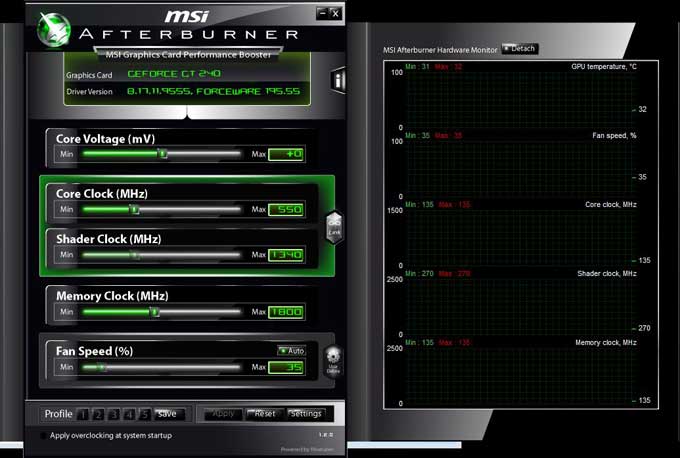
The MSI N240GT-MD512-D5 we received is already an overclocked card from the reference speed with the memory speed at 1800MHz instead of reference 1700MHz. With the MSI’s own Afterburner, it is very easy to adjust the speed for the core, shader and the memory. In addition, the software also let users adjust the voltage.

We were able to overclock the core speed to 620MHz, 1520MHz shader, and 2010MHz memory with the stock voltage.
The amazing thing with the card is that even at the overclocked speed, the card never get above 55C under furmark stress test. In addition, the fan noise is just absolutely quiet.
Power Consumption
The GT 240 is able to perform at 2.5 to 3 times than the 9500 GT yet it only draws 30 watts more power. In addition, under idle condition, the card actually consumes 3 watts less than the 9500 GT. If you are looking for a card that runs cool and does not need high wattage power supply, this is an ideal card for you.
CONCLUSION
For a budget oriented card, we think the NVIDIA GeForce GT 240 is an excellent choice. The card performs quite respectably against the older generation of cards that requires additional power adapter yet it does not need any additional power.
Althogh NVIDIA is late bringing full HDMI support to their graphic cards, we are nonetheless glad to see it has been fully integrate to the GT 240 finally. Now, users no longer need a separate audio cable to bypass the audio through their internal SPDIF and simply use the HDMI cable to get both the video and audio. We think that NVIDIA made a smart choice to incorporate such feature in the GT 240 because we believe it is an ideal card for the HTPC users who are also into light gaming.
The MSI N240GT-MD512 OC/D5 we have reviewed today is a great choice of card for those who are looking for the GT 240. Though we like the dual slot cooler because it keeps our card from running below 60C even under load, we are not too thrill with the dual slot design. The dual slot cooling can be a turn off for those who wish to put the card in an HTPC where space is often limited.
| OUR VERDICT: MSI N240GT-MD512 OC/D5 |
||||||||||||||||||
|
||||||||||||||||||
|
Summary: The native 7.1 audio support through HDMI and DirectX 10.1 support are much welcoming features for the GT 240. The card’s performance is also good for its price. Thus, we feel that this card would be an ideal card for light gamers who are also setting up an HTPC system. |
 Bjorn3D.com Bjorn3d.com – Satisfying Your Daily Tech Cravings Since 1996
Bjorn3D.com Bjorn3d.com – Satisfying Your Daily Tech Cravings Since 1996









